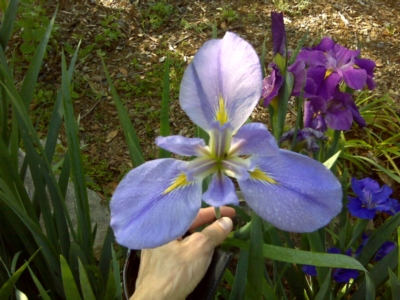
The City Council of New Orleans has proclaimed April 2011, Louisiana Iris-Fleur de Lis Month.
In the 1920s, Dr. John K. Small, Curator of the New York Botanical Garden, dubbed New Orleans the “Iris Center of the Universe.” This was based upon the extraordinary variety of native irises he saw in the wild. Of the five species of Louisiana irises, all are found in Louisiana and all bloom in April. While the Fleur de Lis (strictly speaking) is not a Louisiana iris rather it is Iris pseudacorous with a long history starting with France’s first Christian King, King Clovis (in 507); New Orleans has adopted a stylized version as our symbol for years. It is the symbol of the City’s rebirth and The Saints world champion football team.
During the 1930’s Louisiana locals started hybridizing Louisiana iris species collected from the wild to obtain larger blooms, color variations, and sturdier plants. During the1950’s and 1960’s blooming Louisiana irises could be seen in ditches throughout New Orleans East but by the 1970’s those native stands were eliminated due to habitat destruction. Development, salt water intrusion from the Mississippi River Gulf Outlet, pesticide spraying, over collecting and competition from nonnative species such as the water hyacinth and Iris pseudacorous took a terrible toll. To compound the problem many local nurseries and individuals sold the highly invasive, nonnative Iris pseudacorous as ‘Louisiana irises” to the greater New Orleans population. (Louisiana iris rhizomes are white on the inside whereas the I. pseudacorous is pink. Louisiana iris do not have a central leaf rib where as I. pseudacorous has a midrib.)
When Hurricane Katrina hit in 2005, our public gardens were devastated. Louisiana iris growers donated irises by the thousands and hundreds of volunteers from throughout the U.S. planted them to assist the City with its rebirth.
Master Gardeners of Greater New Orleans and Greater New Orleans Iris Society partnered to develop: A Guide To Louisiana Iris Locations In And Around New Orleans. The Guide includes the following 11 sites where Louisiana irises are available for public viewing:
Longue Vue, Louisiana Iris Display Garden Sydney and Walda Besthoff Sculpture Garden, New Orleans Botanical Garden in City Park, Big Lake New Orleans City Park, Heritage Park Slidell, Plametto Island State Park, Baton Rouge Botanic Garden, Windrush Garden Rural Life Museum Baton Rouge, Town of Jean Lafitte, Joe W. Brown Memorial Park New Orleans East, and The Crosby Arboretum in Picayune Mississippi.
While we cannot bring back the huge colonies of Louisiana irises that occurred in the New Orleans area during the 1900’s, we can admire them in public gardens and grow them in our own. They grow well in containers, raised beds, near ponds or in wet areas of the yard. At least six hours of direct sun will ensure the best bloom. Keep them mulched to avoid sun scald. To encourage deep soaking and conserve water, set a bowl under the sprinkler and turn the sprinkler off when it has filled to a depth of one inch. Allow the water to evaporate before watering again. Since their major growth period is in the winter, they provide greenery when other plants are brown. Fertilize in October and February with 8-8-8. Too much nitrogen will encourage rust. The best time to plant and divide Louisiana irises is in August through October, their dormant period.
Do not collect Louisiana irises from the wild. Use the Guide and visit places where Louisiana irises are on exhibit. Make note of the ones you like. Purchase Louisiana irises from reputable nurseries or hybridizers. Use Louisiana Iris LSU Agriculture Extension Service publication 1969 for advice on culture, planting, dividing, watering, fertilizing, mulching, and pest problems.
In addition to this past weekend’s events at NOMA and the Bestoff Garden, Longue Vue has designated “Louisiana Iris Day: Caroline Dormon’s Legacy in Bloom” in the Wild Garden on April 9th from noon -3:00 pm. The Longue Vue Wild Garden boasts the oldest continuously maintained plantings of Louisiana irises. Caroline Dormon organized the Louisiana iris collection in the Wild Garden for Edith Stern in 1939. Her design, infrastructure and vision are intact and have been beautifully updated with the latest cultivars and numerous examples of forms of the five native species. The public is invited to tour the garden, led by GNOIS members. There is no charge for attending Louisiana Iris Day in the Wild Garden.
General Gardening Tips for April: Annuals, Bulbs, Herbs, Vegetables, Shrubs and Trees
April is the month that cool season annuals really shine, azaleas and other spring-flowering shrubs put on a spectacular show. Tempting as it may be, resist buying the cool-season annual transplants that nurseries continue to carry. Pansy, viola, dianthus, nasturtium, calendula, ornamental cabbage and kale season is near an end. They make colorful garnishes but do not use flowers that have been sprayed with pesticides. Collect seeds of cool-season annuals such as annual phlox, bachelor’s button, sweet pea, larkspur, poppies, nasturtium, calendula, and viola when seedpods begin to yellow or tan.
Pay attention to spacing. Most perennials grow considerably larger than the small transplants you set out. Acanthus, blue star, Louisiana phlox, butterfly weed, Shasta daisy and Indian pink are in bloom. Roses are in bloom and should not be cut back. Deadhead (remove faded flowers) regularly to keep plants attractive and encourage blooming.
Salvage Easter lilies by cutting the flower off but leaving the green foliage. Plant lilies in well-drained soil in a spot that receives morning sun and afternoon shade. If you put a layer of builder’s sand down first it will mark where the lilies are and aid in drainage. The bulbs will go dormant in mid-summer and at that time the yellow foliage may be removed. Also remember to delineate where the bulbs are located with an above ground marker.
Harvest parsley, dill, tarragon, thyme, and cilantro, as they are peaking. In April, when leafy vegetables such as mustard, lettuce, spinach, kale and celery put up flower stalks (bolt) it is time to replace them with warm season vegetables such as tomatoes, snap beans, bell peppers, squash and cucumbers. Herbs to plant include basil, lemon balm, mint (keep contained) and rosemary.
April is an excellent time to repot house plants as the favorable conditions of summer will stimulate growth. Plants become acclimated to low light conditions while indoors. First move them outside to a shady spot where they receive no direct sunlight. Low light loving plants can stay there all summer. Sun-loving house plants like bougainvillea, hibiscus, plumeria, and cactuses can be gradually (over several weeks) moved to places that get six hours or more hours of direct sun. If moved too fast, they may burn. Cut potted poinsettias back half way and plant in a sunny, sheltered (from the North wind) location. Do not plant near street lights as light at night will prevent them from blooming. Remember, house plants moved outside will have to be watered more frequently.
April begins the prime planting season for grasses. Wait until next month to do filling, aerification or dethatching when the grass is growing more vigorously. Sharpen your mower blades in preparation for the summer.
Container-grown trees and shrubs can be planted any time. Do not wait. Planting trees and shrubs when the weather is hot puts them at greater risk. You should have already fertilized existing trees. Prune dead limbs. Have your live oaks sprayed for buck moth caterpillars.
submitted by Eileen Hollander
